
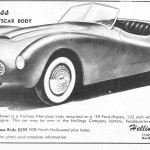
Note:
This is the final installment of a 3 part series of articles on the Johnny Dark Victress, Virgil Rice, Mack Hellings, Bob Stelling, the Hellings Company, and Stelling and Hellings. Here are links to the other parts of the story:
——————————–
Hi Gang…
In the last part of this series, I discussed the specifics of the Victress S1 Roadster in the movie, how it may have been chosen, discussed the background of the driver – Don Freeland, and the history of how the car was found back in the early 1960’s. In this final installment, I share the back story on the people involved with the Hellings Company which later was known as the Stelling and Hellings Company.
Robert “Mack” Hellings
In researching the Hellings company, I started by reviewing early Speed Age Magazines from the 1940’s. I found a great piece on “Mack” that appeared in the “Personality Parade” section of their April 1948 issue. Here are some of the highlights of that article:
* Ronald “Mack” Hellings was born on September 14th, 1915 in Fort Dodge, Iowa. His father was a railroad man so the family moved with the job, spending time in Lander Wyoming and Billings Montana before moving to Los Angeles in 1935.
* He attended Hollywood’s Fairfax High School, and started racing motorcycles in 1937, switching to midgets in 1939.
* In 1946, he placed second in the first 250 lap race in the Los Angeles Coliseum, behind Sam Hanks, and the next week he won the premier race in Pasadena’s famous Rose Bowl.
* Mack was a template expert and was employed by Northrup and Lockheed Aircraft from 1936 to 1945.
* He was married in 1948, but his wife worried about his safety and did not watch him race.
* The Hellings logo was patterned to look like “Mack”. However, the moustache was exaggerated to look like a motorcycle handlebar – ones that he made and sold (and the company continued selling thru the 1960’s and 1970’s.
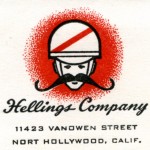
This is One of my Favorite Logos of the 1950’s – Here You Can See How Mack Used the Moustache in the Logo as a Way to Emulate the Motorcycle Handlebars He Was Selling at His Company.
In further research, I located a story on the Internet giving more detail on Mack after 1948. Here are some of the details:
* In July 1947, Hellings, who gained the nicknames “Monopoly Mack” and “The Burbank Bombshell,” won again in a 30-lap race at the Rose Bowl — his fifth victory in eight races on the track. He also had eight wins in 11 starts at the Culver City Speedway.
* On Oct. 5, 1947, Hellings won a 50-lap race at the Rose Bowl which was billed as the American Midget Racing Association’s national championship race. Hellings also finished first in one of two 100-lap qualifying races. In January 1948, Hellings was named champion of the United Racing Association’s Blue Circuit.
* Hellings tried out for the Indianapolis 500 in 1948 and, in typical Hellings style, he won $500 by setting the day’s fastest qualifying time. Hellings started the race in the 21st position, and finished in fifth place. A month later, Hellings finished second — seven seconds behind the winner — in the 100-mile AAA national championship race at Langhorne Speedway in Langhorne, Pennsylvania
* Hellings qualified for the Indy 500 again in 1949, and finished 16th after his car suffered mechanical problems. He finished in 13th place in 1950, and 31st place in 1951, after dropping out due to engine problems. Mack drove at “Indy” a total of four times.
You can read more details about “Mack” on the following website:
Click Here to Review History on Robert “Mack” Hellings
As reported in the earlier article on the Johnny Dark Victress, some of the parts (grill, door hinges) were made from motorcycle parts. This was not by accident. Mack Hellings started out building a motorcycle business in his backyard in 1945 or earlier. The business started out exclusively selling motorcycle specialty items and perhaps service on motorcycles, but quickly expanded into automotive parts as well.

What a Great Piece of Literature that Hellings Put Together (under Stewardship of Virgil Rice) to Promote the Sales of Victress Bodies via Hellings Company.
So far, the earliest ad I can find for Hellings appeared in the November 1950 issue of Motor Trend. Research continues and I’m looking for more ads from Hellings Company each day to complete the early history of this company.
During our research on Hellings, I was saddened to find out that Mack Hellings died in a tragic plane crash on November 11th, 1951. He was just 36 years old. He had competed in the Indianapolis 500 just a few months before passing away. But this was confusing to me because this was the same month and year that Glasspar, Lancer, and the Skorpion/Wasp debuted at the Petersen Motorama. The Victress S1A wasn’t yet designed or built – that wouldn’t happen for approximately another year.
So who owned and/or ran Hellings and established the relationship between Victress and Hellings when the Johnny Dark Victress was built?
Clearly more research was needed.
Virgil Rice / Vergil Rice, Victress, and the Hellings Company
Virgil Rice (as I was conducting my research, I also discovered that it was spelled Vergil Rice – and perhaps this was the accurate spelling) was General Manager of Hellings from at least late 1951 thru early to mid 1954. This information was gleaned from an interview published in the 1994 Tom Medley book “Hot Rod History” where future owner of the company, Bob Stelling discussed how he got involved with the Hellings Company. More about that interview with Stelling later.
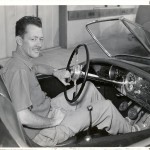
Here Virgil Rice is Seen at the Wheel of the Car He Had Just Completed – the Hellings Victress – Soon to be “The Johnny Dark Victress”
Unfortunately Virgil passed away nearly 20 years ago, and his wife many years afterward. We’re still searching for his children, and hope to find them and Virgil’s full history in the near future. For now, here’s what we know about Virgil and his car:
* Virgil was General Manager of Hellings thru early 1954 when he left the Hellings Organization.
* He may have joined the Hellings company as a result of the death of Mack Hellings in late 1951, but it’s possible he was there before Mack’s passing.
* Virgil established the close relationship between Victress and Hellings, and this relationship blossomed thru early 1954 (as verified by dated Hellings brochures, published Hellings advertising, dated letters from Hellings, and direct interviews with Victress founders and employees which confirmed the relationship which include Merrill Powell and Bill Quirk).
* Hellings was the first and only dealer in the early days of the Victress body. Hellings was not an exclusive dealer – Victress also sold directly to the public. This relationship lasted thru all of 1953 and the early to mid part of 1954
* Only one car was built by Hellings – a Studebaker powered Victress S1 that later became the Johnny Dark Victress
* Hellings only advised interested parties on how to built a Victress sports car. They provided a sheet on how to modify a Ford frame to fit a Victress S1 body, and later this sheet was modified to show the updated S1A body. This was also confirmed by Wally Lee who still owns a Victress S1A that he helped build in the late 1950’s with his friend and the advice of the Hellings Company.
After Virgil Rice left Hellings in 1954, the relationship between Hellings and Victress softened. Bob Stelling was now at the helm of the Hellings Company, and he wanted to take the company in a different direction that didn’t include the dealership focus on Victress bodies. Merrill Powell also joined Victress in late 1953 and by early 1954 he reports that most bodies were sold directly by Victress as their organization continued to grow. So the Hellings era of Victress started and ended in about a year (1953-1954).
It should be noted that in the early 1960’s, Art Evans distributed the Victress bodies from his company EI: Evans Industries. They also advertised the Byers bodies too. However, in a personal communication with Art Evans in January 2009, Art reported that he knew Doc Boyce Smith (from the mid 1950’s when he tried out a Victress S5 body on his racing MG) and floated the idea of selling bodies as a dealership, but he started back teaching in the Fall of 1960 and that the EI dealership was never formalized nor any Victress or Byers bodies sold.
Doc Boyce Smith and Merrill Powell sold the company to Les and Joan Dawes of LaDawri Coachcraft in 1961, and the era of Victress which was the longest and most successful producer (pioneer) of fiberglass sports car bodies from the early 1950’s was over.
Robert John “Bob” Stelling
Let’s go back a bit in our story.
Most of us have heard of Stelling and Hellings, but how did that originate and when did it start? In my quest for the answer, I tracked down the children and families of Mack Hellings and Bob Stelling and they were more than willing to help fill in some of the missing information.
I found the earliest reference to a Bob Stelling business in the August 1949 issue of Hot Rod. In this issue, the magazine announced that Stelling was going into production of a new oil breather and an ad was run in the same issue by Stelling for these same oil breathers. So by the late 1940’s, “Stelling” was up and running in the automotive business in Southern California.
But Stelling was a busy man.
Stelling was good friends with Robert “Bob” Barker (as reported in the 1990 Tom Medley book Hot Rod History) and was running both his own business (Stelling) and built rocker arms and gear boxes for Barker’s Company, B&B Automotive in Burbank California, in the early 1950’s. Mack Hellings was also good friends with Barker – and competed against him in racing circles in the late 1940’s.
So most likely, these two men (Mack Hellings and Bob Stelling) knew each other thru their mutual friend Bob Barker, and in fact may have known each other much earlier – even before Barker got involved.

This is the Earliest Ad I’ve Found for Stelling. It appeared in the September 1949 Issue of Hot Rod Magazine.
We do not know how much Bob Stelling was involved with Mack’s “Hellings Company” in the early 1950’s, but as reported in Stellings biography in the 1990 Tom Medley book, he helped with the Hellings Company and at some point in 1954 took it over.
At about the same time, he fell in love with and married Bette Hellings. Mack and Bette had a young son, Barry, and Barry was adopted by Bob becoming a “Stelling” in the process. In 1955 or 1956, Bob moved the Hellings Company from their 11423 Van Owen Street, North Hollywood address to their new location in Burbank (2800 West Burbank Blvd, Burbank California) and soon changed the name to “Stelling and Hellings” – keeping the “Hellings” name to honor his good friend Mack.
Bob and Bette Stelling had two more children, Brad and Brett. The Stelling family closed “Stelling and Hellings” for good when their dad passed away in February 2001.
Summary
So there you have it – an overview on the background of three important men – Virgil Rice, Mack Hellings, and Bob Stelling. Great appreciation goes to Brad Stelling for his help in clarifying the details on the history of their company.
I hope you’ve enjoyed the article, and look forward to the restoration of this special car. No doubt its debut will again shine the spotlight on Virgil Rice, Mack Hellings, Bob Stelling, Victress, and the Johnny Dark Movie – a very special time during the golden age of sports cars in America.
Glass on gang….
Geoff
- Terrific Picture of Mack Hellings at the Wheel of One of the Race Cars He Drove in the Late 1940’s
- Another Ad for a Product Sold By Hellings – This Ad Appeared in Motor Sports World July 19th, 1953
- Here Vergil Rice is Seen at the Wheel of the Car He Had Just Completed Building – the Hellings Victress – Soon to be “The Johnny Dark Victress”
- Here’s the First Appearance of Victress in Any Magazine – July 31st, 1953 in Motor Sports World. In This Ad, the Public is Invited to Come Into Hellings and See The “Soon to Be” Johnny Dark Victress.
- What a Great Piece of Literature that Hellings Put Together (under Stewardship of Virgil Rice) to Promote the Sales of Victress Bodies via Hellings Company.
- This is One of my Favorite Logos of the 1950’s – Here You Can See How Mack Used the Moustache in the Logo as a Way to Emulate the Motorcycle Handlebars He Was Selling at Hellings Company.
- Here Bob Stelling is Shown in the Early 1990’s
- This is the Earliest Ad I’ve Found for Stelling. It appeared in the September 1949 Issue of Hot Rod Magazine.
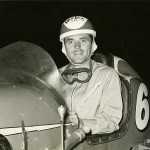
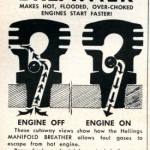


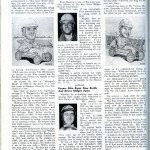
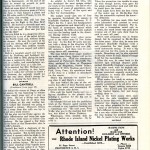
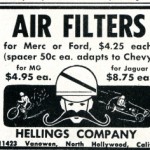


Hello.
Thank you for this wonderful story.
We grew up on Florence Street, 3 doors down from Stelling Helling’s business.
As kids we would stop by and see what they were always working on.
We finally, as kids restored a 32 3 window coupe. and used the products on the flathead.
Also on a Big block chevy in our boat.
?- what happen to the business? do you know.?
Thank you
kevin Stolpe – kevin5754@gmail.com
My uncle Donald Graff worked at Stelling and Hellings . I remember going there ans seeing the things they were making. Handlebars Rocker arms and A Mustang Scooter with a triumph engine.
I had a stelling and helling decal on my 62 VW bug.